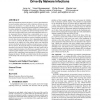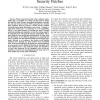832 search results - page 57 / 167 » Effect of Malicious Synchronization |
CCS
2010
ACM
13 years 10 months ago
2010
ACM
Web-based surreptitious malware infections (i.e., drive-by downloads) have become the primary method used to deliver malicious software onto computers across the Internet. To addr...
P2P
2010
IEEE
13 years 7 months ago
2010
IEEE
Abstract--When a host discovers that it has a software vulnerability that is susceptible to an attack, the host needs to obtain and install a patch. Because centralized distributio...
ICDCS
2012
IEEE
12 years 10 days ago
2012
IEEE
—Virtual coordinate systems (VCS) provide accurate estimations of latency between arbitrary hosts on a network, while conducting a small amount of actual measurements and relying...
ESORICS
2010
Springer
13 years 11 months ago
2010
Springer
Fair exchange is one of the most fundamental problems in secure distributed computation. Alice has something that Bob wants, and Bob has something that Alice wants. A fair exchang...
CHI
2002
ACM
14 years 10 months ago
2002
ACM
Two experiments investigated the effects of system response time (SRT) on hypertext navigation. Dependent variables were residence time, emotional strain and memory performance. A...


